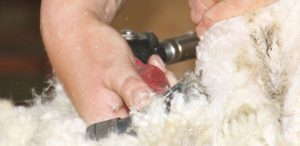 AUSTRALIA’S wool production for the current financial year is predicted to be 305 million greasy kilograms, almost 11 percent lower than in 2017-18, due to dry conditions, lower fleece weights and increased slaughter of sheep.
AUSTRALIA’S wool production for the current financial year is predicted to be 305 million greasy kilograms, almost 11 percent lower than in 2017-18, due to dry conditions, lower fleece weights and increased slaughter of sheep.
The Australian Wool Production Forecasting Committee today forecasted a 10.8pc drop in shorn wool production in 2018-19, down from its 2017-18 estimate of 341mkgs.
High sheep slaughter to the end of September is expected to reduce the number of sheep shorn in 2018-19 by 6.6pc to 71.7 million head, with a 4.4pc reduction in annual average cut per head to 4.25 kg as a result of the tough seasonal conditions.
Continuing dry conditions in New South Wales, Queensland, northern Victoria, east Gippsland and the northern parts of South Australia have been tempered somewhat by the better seasonal conditions in the south-east South Australia, the midlands of Tasmania, western Victoria and parts of Western Australia.
AWPFC chairman, Russell Pattinson said the committee brought forward their usual December meeting into November to provide the industry with an updated forecast for the remainder of the current season.
“The second forecast made in August at 322 mkg was contingent on how the season progressed over the Spring period.
“Tough seasonal conditions have continued in many regions and as the wool textile industry is monitoring the situation closely, it was important to provide updated information to the market,” he said.
Mr Pattinson said the season continues to be very difficult through most of NSW and Queensland, northern Victoria and east Gippsland, northern South Australia and parts of southern Western Australia”.
“In these regions, both the number of sheep shorn and the annual average cut per head are expected to decline considerably. Shorn wool production in NSW is expected to decline by 20pc to 100 mkg and by 14pc in Queensland to 7.1 mkg compared to the 2017-18 season.”
Shorn wool production is expected to fall by amounts varying between 0.3pc in Tasmania and 8pc in South Australia. Rain in October and early November has slightly improved the outlook for wool production in parts of the country. For other wool producing areas, the situation has been more positive with the southeast of South Australia, western Victoria, Tasmania and parts of Western Australia having better seasons that other parts of the country, the committee said.
The committee noted that for the 2018-19 season to the end of October, the AWTA test data showed a large increase in the weight of wool tested in all micron ranges up to 18.5 microns as well as a large decline in the weight of 20 to 23 micron wool and 28.6 microns and broader wool. Volumes have generally fallen for other micron ranges. The average mean fibre diameter for the season to the end of October was 20.1 microns, down by 0.5 microns. The average staple length across Australia has fallen by 3.2 mm to 85.8 mm, with all states recording shorter staple length for the season to date compared with the same period in 2017-18.
Source: AWI.

HAVE YOUR SAY